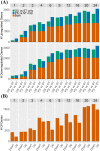Systems biology analysis of longitudinal functional response of endothelial cells to shear stress
- PMID: 28973892
- PMCID: PMC5642700
- DOI: 10.1073/pnas.1707517114
Systems biology analysis of longitudinal functional response of endothelial cells to shear stress
Abstract
Blood flow and vascular shear stress patterns play a significant role in inducing and modulating physiological responses of endothelial cells (ECs). Pulsatile shear (PS) is associated with an atheroprotective endothelial phenotype, while oscillatory shear (OS) is associated with an atheroprone endothelial phenotype. Although mechanisms of endothelial shear response have been extensively studied, most studies focus on characterization of single molecular pathways, mainly at fixed time points after stress application. Here, we carried out a longitudinal time-series study to measure the transcriptome after the application of PS and OS. We performed systems analyses of transcriptional data of cultured human vascular ECs to elucidate the dynamics of endothelial responses in several functional pathways such as cell cycle, oxidative stress, and inflammation. By combining the temporal data on differentially expressed transcription factors and their targets with existing knowledge on relevant functional pathways, we infer the causal relationships between disparate endothelial functions through common transcriptional regulation mechanisms. Our study presents a comprehensive temporally longitudinal experimental study and mechanistic model of shear stress response. By comparing the relative endothelial expressions of genes between OS and PS, we provide insights and an integrated perspective into EC function in response to differential shear. This study has significant implications for the pathogenesis of vascular diseases.
Keywords: RNA-seq; endothelial cells; shear stress; systems biology; time-series analysis.
Conflict of interest statement
The authors declare no conflict of interest.
Figures









References
-
- Chistiakov DA, Orekhov AN, Bobryshev YV. Effects of shear stress on endothelial cells: Go with the flow. Acta Physiol (Oxf) 2017;219:382–408. - PubMed
Publication types
MeSH terms
Substances
Grants and funding
LinkOut - more resources
Full Text Sources
Other Literature Sources
Molecular Biology Databases

